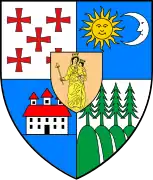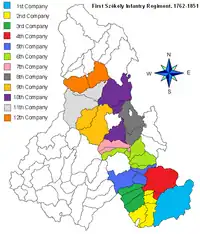Frumoasa, Harghita
Frumoasa (Hungarian: Szépvíz or Csíkszépvíz, Hungarian pronunciation: [ˈtʃiːkseːpviːz]) is a commune in Harghita County, Romania. It lies in the Székely Land, an ethno-cultural region in eastern Transylvania.
Frumoasa
Csíkszépvíz | |
|---|---|
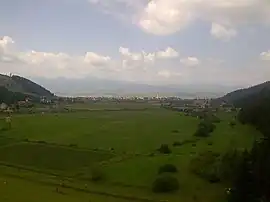 View from the reservoir | |
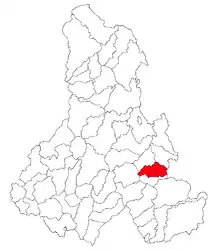 Location in Harghita County | |
 Frumoasa Location in Romania | |
| Coordinates: 46°27′N 25°51′E | |
| Country | Romania |
| County | Harghita |
| Government | |
| • Mayor (2020–2024) | Tibor Ferencz[1] (UDMR) |
| Area | 84.06 km2 (32.46 sq mi) |
| Population (2011-10-31)[2] | 3,682 |
| • Density | 44/km2 (110/sq mi) |
| Time zone | EET/EEST (UTC+2/+3) |
| Postal code | 537115 |
| Area code | +40 266 |
| Vehicle reg. | HR |
| Website | www |
Component villages
The commune is composed of four villages:
| In Romanian | In Hungarian |
|---|---|
| Bârzava | Csíkborzsova |
| Făgețel | Bükkloka |
| Frumoasa | Csíkszépvíz |
| Nicolești | Csíkszentmiklós |
History
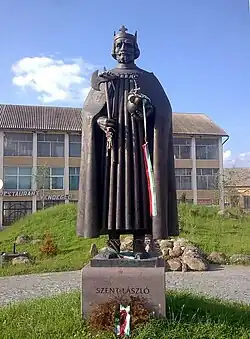
The first written mention of the village is from 1567 as Zepwyz. In 1602 it was recorded as Szépviz ("beautiful water"). Its original Romanian name derived from the Hungarian toponym as Ciuc-Sepviz which was Romanianized to its current official name in 1919.[3]
According to tradition, the village's original name was Szépmező. According to Balázs Orbán, it was founded during the reign of László I as a community of border guards for the defense of the Ghimeș pass, on the eastern border of the Kingdom of Hungary. The Roman Catholic chapel was built before 1694 by the Bíró family. The Roman Catholic church was built in 1892.
The village administratively belonged to Csíkszék, then, from 1876 until 1918 to the Csík County in the Kingdom of Hungary. After World War I, by the terms of the Treaty of Trianon of 1920, it became part of Romania. As a result of the Second Vienna Award, it belonged to Hungary again between 1940 and 1944. After World War II, it came under Romanian administration and became part of Romania in 1947. Between 1952 and 1960, it formed part of the Hungarian Autonomous Province; it then formed part of the Mureș-Hungarian Autonomous Province until it was abolished in 1968. Since then, the commune has been part of Harghita County.
Demographics
At the 2011 census, the commune had a population of 3,682; out of them, 94% were Hungarian, 2.3% were Romanian and 1.7% were Roma.[4]
The village of Făgățel has a significant population of ethnic Romanians, numbering 64 of the village's 130 inhabitants.
Natives include Piroska Abos.
Tourist attractions
- Saint Gregory the Illuminator Armenian Church
- 'Snowy' Virgin Mary Catholic Parish Church
- Ruins of the St. Ladislaus Gothic chapel on Pagan Mountain
- Biró-Chapel (Craftsmen's Chapel)
- Ski track
Gallery
 As "Szép Víz" on 18th century map (Josephine Land Survey)
As "Szép Víz" on 18th century map (Josephine Land Survey) The reservoir
The reservoir.jpg.webp) The reservoir
The reservoir View of Făgeţel (Bükkloka)
View of Făgeţel (Bükkloka) Saint Ladislaus Church
Saint Ladislaus Church
References
- "Results of the 2020 local elections". Central Electoral Bureau. Retrieved 10 June 2021.
- "Populaţia stabilă pe judeţe, municipii, oraşe şi localităti componenete la RPL_2011" (XLS). National Institute of Statistics.
- János András Vistai. "Tekintő – Erdélyi Helynévkönyv".
{{cite web}}: Missing or empty|url=(help)Transylvanian Toponym Book Archived 10 July 2011 at the Wayback Machine - Tab8. Populaţia stabilă după etnie – judeţe, municipii, oraşe, comune, 2011 census results, Institutul Național de Statistică, accessed 20 February 2020.
